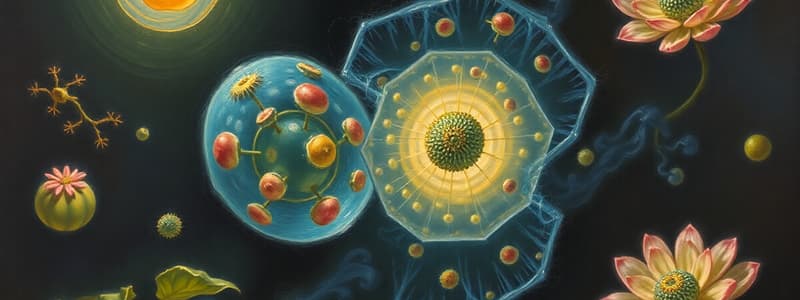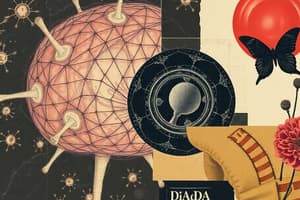Podcast
Questions and Answers
What is the primary goal of homeostasis in living organisms?
What is the primary goal of homeostasis in living organisms?
- To maintain relatively constant internal conditions (correct)
- To promote cell division and growth
- To eliminate waste from the body
- To increase metabolic rates
Which of the following is NOT an example of a condition maintained through homeostasis?
Which of the following is NOT an example of a condition maintained through homeostasis?
- Nutrient absorption (correct)
- Blood glucose levels
- Body temperature
- Heart rate
How does the body primarily respond to an increase in internal temperature?
How does the body primarily respond to an increase in internal temperature?
- By increasing heart rate to distribute heat
- By inducing sweating to cool the skin (correct)
- By increasing blood glucose levels
- By dilating blood vessels to retain heat
What characterizes a failure in homeostatic regulation?
What characterizes a failure in homeostatic regulation?
Which mechanism is primarily associated with maintaining blood glucose levels?
Which mechanism is primarily associated with maintaining blood glucose levels?
What is the main purpose of the control group in an experiment?
What is the main purpose of the control group in an experiment?
Which variable is manipulated by the researcher in an experiment?
Which variable is manipulated by the researcher in an experiment?
Which of the following is considered a characteristic of living organisms?
Which of the following is considered a characteristic of living organisms?
What describes the role of producers in an ecosystem?
What describes the role of producers in an ecosystem?
How does homeostasis relate to internal conditions in living organisms?
How does homeostasis relate to internal conditions in living organisms?
Which of the following best represents a detritivore's role in an ecosystem?
Which of the following best represents a detritivore's role in an ecosystem?
What is a defining feature of the dependent variable in an experiment?
What is a defining feature of the dependent variable in an experiment?
In a vaccination trial, which group receives the treatment being tested?
In a vaccination trial, which group receives the treatment being tested?
What is the primary function of cohesion in water molecules?
What is the primary function of cohesion in water molecules?
Why is water considered a good solvent?
Why is water considered a good solvent?
What characteristic of water contributes to ice floating?
What characteristic of water contributes to ice floating?
What is the main source of energy provided by carbohydrates?
What is the main source of energy provided by carbohydrates?
Which biological molecules are primarily responsible for controlling chemical reactions?
Which biological molecules are primarily responsible for controlling chemical reactions?
What type of reaction do enzymes that are classified as catabolic perform?
What type of reaction do enzymes that are classified as catabolic perform?
Which of the following is NOT a function of proteins?
Which of the following is NOT a function of proteins?
Which macromolecule is primarily responsible for storing genetic information?
Which macromolecule is primarily responsible for storing genetic information?
Study Notes
Homeostasis
- Maintains relatively constant internal conditions
- Examples include body temperature, blood glucose levels, heart rate
Hierarchy of Life
- Atom
- Molecule
- Organelle
- Cell
- Tissue
- Organ
- Organ System
- Organism
- Population
- Community
- Ecosystem
- Biosphere
Original Cell Theory
- All organisms are made up of one or more cells
- The cell is the fundamental unit of life
- All cells come from preexisting cells
Atomic Structure
- Atoms consist of protons, electrons, and neutrons.
- Protons have a positive charge and are located in the nucleus.
- Electrons have a negative charge and are located in shells surrounding the nucleus.
- Neutrons have no charge and are located in the nucleus.
- First electron shell holds up to 2 electrons
- Second electron shell holds up to 8 electrons
- Third electron shell holds up to 8 electrons
Periodic Table of Elements
- The number of protons in an element is its atomic number.
- The atomic number defines the element.
- Atomic mass is the atomic number plus the number of neutrons.
Bulk Elements in Living Organisms
- Oxygen
- Nitrogen
- Carbon
- Hydrogen
Acids and Bases
- Acids have a high concentration of hydrogen ions (H+) and a low concentration of hydroxide ions (OH-).
- Bases have a low concentration of hydrogen ions (H+) and a high concentration of hydroxide ions (OH-).
- Neutral solutions have equal concentrations of hydrogen and hydroxide ions.
- The pH scale measures the acidity or alkalinity of a solution.
- A pH of 1-6 is acidic, 7 is neutral, and 8-14 is basic.
Chemical Bonds
- Atoms form chemical bonds to fill their outer electron shell.
- Covalent bonds involve the sharing of electrons between atoms.
- Ionic bonds involve the transfer of electrons between atoms.
- Hydrogen bonds are weak attractions between a hydrogen atom and an electronegative atom, such as oxygen or nitrogen.
Properties of Water
- Cohesion: Water molecules are attracted to each other due to hydrogen bonding. This property helps water move from plant roots to leaves.
- Adhesion: Water molecules are attracted to non-water substances. This property helps water adhere to surfaces.
- Temperature Regulation: Water can absorb and release a lot of heat without changing temperature drastically. This helps organisms maintain a stable body temperature.
- Solvent: Water is a good solvent because it is a polar molecule. This allows it to dissolve many substances, which is important for transporting solutes in the bloodstream.
- Density: Water is less dense as a solid than as a liquid. This is why ice floats, which allows life to exist in water even during cold temperatures.
Organic Molecules
- Carbohydrates
- Proteins
- Lipids
- Nucleic Acids
Carbohydrates
- The monomer of carbohydrates is a monosaccharide.
- Carbohydrates are the main source of energy for living organisms.
- Examples include sugars, starches, and cellulose.
Proteins
- The monomer of proteins is an amino acid.
- Proteins have a variety of functions in living organisms, including:
- Structural support
- Enzyme catalysis
- Hormone regulation
- Storage
- Transport
- Cell signaling
Lipids
- Contain fats, oils, waxes, and steroids.
- Important for energy storage.
- Phospholipids are a major component of cell membranes.
Nucleic Acids
- The monomers of nucleic acids are nucleotides.
- DNA and RNA are examples of nucleic acids.
- Nucleic acids store and transmit genetic information.
Enzymes
- Enzymes are proteins that speed up chemical reactions.
- Anabolic reactions join smaller molecules to create larger molecules.
- Catabolic reactions break down larger molecules into smaller molecules.
- Enzymes have a specific shape that only fits the substrate it acts on, called enzyme-substrate specificity.
Studying That Suits You
Use AI to generate personalized quizzes and flashcards to suit your learning preferences.
Related Documents
Description
Test your knowledge on fundamental biological concepts including homeostasis, the hierarchy of life, and the original cell theory. This quiz covers essential topics such as atomic structure and the periodic table of elements, providing a comprehensive overview of biology fundamentals.




